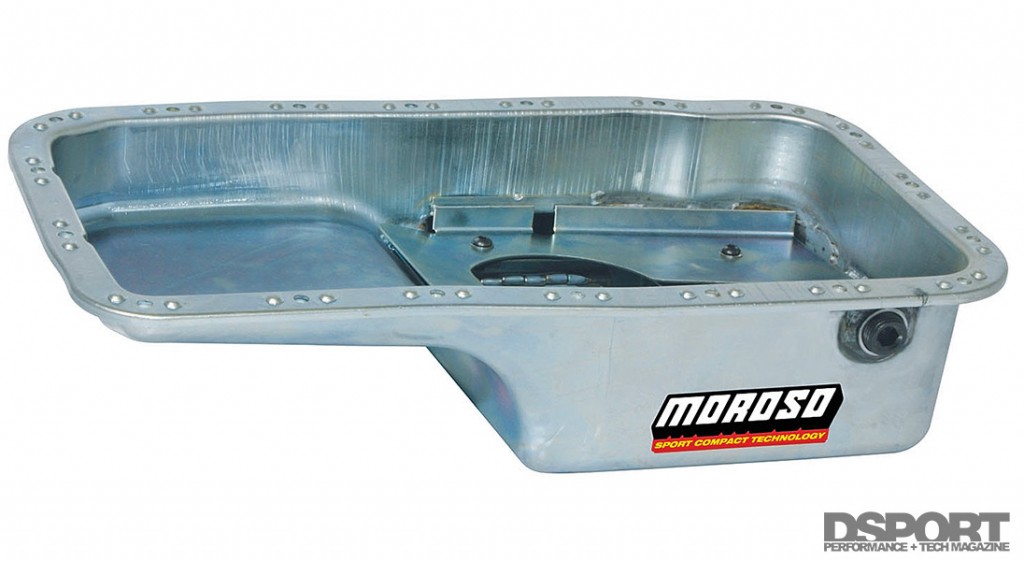The human body can’t live without blood. Blood delivers oxygen, nutrients and other essential substances to the body and its organs. Similarly, oil serves an essential role in the performance and operation of the engine. Oil is responsible for lubricating, cooling and removing contaminants for nearly all moving parts. However, oil breaks down over time due to contamination, heat and shearing. As an oil’s viscosity breaks down, it loses its ability to protect the engine. Fortunately, there are components that can improve your engine’s oiling system and prolong oil life.
Staff Report
DSPORT Issue #105
The oiling system of an engine (pan, pickup, pump, reservoir, etc.) transports oil through galleys to critical engine components. Most factory oiling systems perform an adequate job of lubrication on stock to mildly- tuned street-driven vehicles. However, as power levels increase and driving conditions change (road racing, drag racing, drifting), the stock oiling system can prove inadequate. [pullquote]THE ENGINE IS BY FAR THE MOST AFFECTED BY POOR LUBRICATION[/pullquote] The extreme g-forces associated with racing can cause the oil in the pan to lose contact with the pickup. When the pickup is sucking air and not oil, the resulting oil starvation damages the engine. A basic understanding of the major components in an engine’s oiling system can help one decide which components need to be upgraded for a particular style of racing or level of performance modification.
Three of A Kind
There are three major areas in a vehicle’s powertrain that require oil to function properly; the engine, transmission and differential. Of the three, the engine is by far the most affected by poor lubrication. Oil starvation in the engine can cause metal-to-metal contact between bearings, gears, chains, rings, pistons and cams resulting in premature wear and failure. The engine’s oil pump is responsible for pumping oil to the galleys, bearings and journals that lubricate these important areas. If the oil pump is being starved for oil or cannot provide the proper oil pressure, severe engine damage can occur.
Dry or Wet
There are two major types of oil pump systems used in combustion engines, wet-sump and dry-sump. Nearly all production and some classes of racecars use a wet-sump system (when allowed by class rules). The wet-sump system refers to an oiling system that stores the reserve oil in an oil pan, hence the term wet sump. On a wet-sump setup, the oil pump draws oil through a pickup, pumps it through an oil filter to remove harmful debris and through the engine to the multiple points of lubrication. Dry-sump systems found on high-performance cars combat oil starvation during hard cornering or extreme acceleration. A dry-sump system stores the oil in an external reservoir. An external oil pump (2-stage pump minimum) scavenges oil from the oil pan and pumps it into the reservoir (dry-sump tank). Besides oil storage, the dry-sump tank separates air from the oil and prevents the oil from foaming. From the tank, the second stage of the pump circulates the oil back through the engine. A dry-sump system also helps increase power production by reducing windage at the crankshaft. Engines using a dry-sump system also benefit from the vacuum effect created within the crankcase leading to higher horsepower production. Besides the benefit of reducing the chances of oil starvation, the smaller oil pan allow the engine to be mounted lower, effectively lowering the vehicle’s center of gravity. The drawback of dry-sump systems is the high cost and the extra components (sump tank, lines, pump, block off plate, etc.) that are required.
Dry-sump systems found on high-performance cars combat oil starvation during hard cornering or extreme acceleration. A dry-sump system stores the oil in an external reservoir. An external oil pump (2-stage pump minimum) scavenges oil from the oil pan and pumps it into the reservoir (dry-sump tank). Besides oil storage, the dry-sump tank separates air from the oil and prevents the oil from foaming. From the tank, the second stage of the pump circulates the oil back through the engine. A dry-sump system also helps increase power production by reducing windage at the crankshaft. Engines using a dry-sump system also benefit from the vacuum effect created within the crankcase leading to higher horsepower production. Besides the benefit of reducing the chances of oil starvation, the smaller oil pan allow the engine to be mounted lower, effectively lowering the vehicle’s center of gravity. The drawback of dry-sump systems is the high cost and the extra components (sump tank, lines, pump, block off plate, etc.) that are required.



